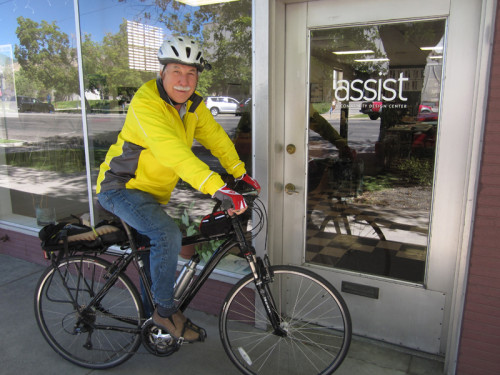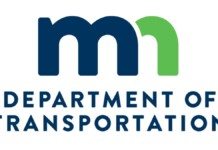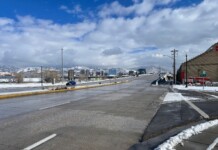By Ashley Patterson

Roger Borgenicht is the Executive Director of ASSIST, a nonprofit community design center formed in 1969 to provide design services for low income Utahns. ASSIST provides architectural design, community planning and development assistance to nonprofit and community groups, and housing repair and accessibility design assistance to low income households or persons with disabilities. Roger is trained as an architect and a planner and has lived in Salt Lake City since 1984. With urban planning focusing more and more on bicycle infrastructure, it was a natural fit for Roger to begin riding a bicycle to work three years ago and he quickly fell in love with it. “A big job of community planners is to reduce dependence on the automobile and through personal experience, I’ve learned that the bicycle is just simply a more sensible urban mobility mode of transport.”
His daily commute to work is about two and a half miles each way with a downhill cruise to work in the morning and a slight climb home in the afternoon. He often rides up to 11th Avenue and back down to his home for some extra exercise and indeed, he started riding his bike to work a few years ago mainly to find a way to get more exercise during the busy work week. He figured if he made it a daily habit, he’d get 20-30 minutes of exercise each day getting to and from his office. He was also
growing increasingly concerned about the worsening air quality and did not want to be a personal contributor, and felt that 3000 pounds of steel was a bit of overkill for people to make short trips. Additionally, the desire to slow down a bit to offset the ever quickening pace of modern life was strong as was his increasing interest in the urban bicycle culture, fostered by Roger’s grown son, who barely drives a car (nor do his friends) and was a strong inspiration.
Like most bike commuters, Roger has caught the bug and now hardly drives to work at all and indeed feels a bit odd when he does drive to work. “I don’t like ice and snow and bitter cold, but otherwise I’m generally on the bike. It takes a bit more commitment in the dark of winter, but it’s added so much pleasure to my commute and my life. I don’t rush as much and I really like the transition it provides at the end of my day.” He has panniers and baskets so he can grocery shop on the way home if needed, and because he has so many meetings downtown outside of his office, the bike has proven to be a better way than his car to get around downtown. His co-workers seem to agree, given that of six employees at ASSIST, there are typically three bikes in their office each day.
In addition to riding to work, he and his wife enjoy bicycle outings on the weekends; up City Creek Canyon and down to the Farmers Market or other local community events. He rides a road bike that he outfitted with good lights and a rack and he wears bright yellow all the time so he’s visible to motorists. In the years he’s been commuting, he’s noticed more and more cyclists on the roads: “The other day, there were six cyclists at the corner of 200 S. and 400 E. and I thought to myself, we’re beginning to matter here!”
When asked what advice he would give to potential bicycle commuters, Roger responds that his advice is given more to planners and government officials than to potential commuters: “60% of people will ride a bike if there are separated and protected bike lanes. 6% of people will ride regardless of the bicycle infrastructure. If we invest in simple and intuitive infrastructure for bicyclists, we can potentially have an order of magnitude increase in bicycle commuters. That’s a difference which will have a tremendous impact on air quality, congestion and quality of life in our City.”
He concludes by saying, “I want to see the bicycle return to where it is seen as a major piece of urban transport and not a marginal use.”
With folks like Roger working toward that goal, we might just get there.
If you have a suggestion for a commuter profile, have a commuter question, or other comments, please send it to [email protected].











